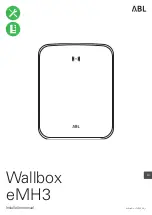
2
BWC155
BATTERY CHARGER
6/12/24 VOLT 70/65/30 AMP
027
-
1060 Rev. 20190220
1902045
-
11
17.
FOLLOW THESE STEPS WHEN THE BATTERY IS
INSTALLED IN A VEHICLE. A SPARK NEAR THE
BATTERY MAY CAUSE A BATTERY EXPLOSION.
TO REDUCE THE RISK OF A SPARK NEAR THE
BATTERY:
a.
Position the AC and DC cords to reduce the risk of damage by the
hood, door, or moving engine parts.
b.
Stay clear of fan blades, belts, pulleys, and other parts that can
cause injury to persons.
c.
Check the polarity of the battery post. The POSITIVE (POS, P, +)
battery post usually has a larger diameter than the NEGATIVE (NEG,
N,
-
) post.
d.
Determine which post of the battery is grounded (connected) to the
chassis. If the negative post is grounded to the chassis (as in most
vehicles), see item "e". If the positive post is grounded to the chas-
sis, see item "f".
e.
For negative
-
grounded vehicles, connect the POSITIVE (RED) clamp
from the battery charger to the POSITIVE (POS, P, +) ungrounded
post of the battery. Connect the NEGATIVE (BLACK) clamp to the
vehicle chassis, heavy gauge metal part of the frame, or engine
block, away from the battery. Do not connect to the carburetor, fuel
lines, or sheet metal body parts.
f.
For positive
-
grounded vehicles, connect the NEGATIVE (BLACK)
clamp from the battery charger to the NEGATIVE (NEG, N,
-
) un-
grounded post of the battery. Attach the POSITIVE (RED) clamp to
the vehicle chassis or engine block away from the battery. Do not
connect the clamp to the carburetor, fuel lines, or sheet
-
metal body
parts.
g.
When disconnecting the charger, turn the switch to OFF, disconnect
the AC cord, remove the clamp from the vehicle chassis, and then
remove the clamp from the battery terminal.
h.
See the operating instructions for length of charge information.
18.
FOLLOW THESE STEPS WHEN THE BATTERY IS
OUTSIDE THE VEHICLE. A SPARK NEAR THE
BATTERY MAY CAUSE BATTERY EXPLOSION.
TO REDUCE THE RISK OF A SPARK NEAR THE
BATTERY:
a.
Check the polarity of the battery post. The POSITIVE (POS, P, +)
post usually has a larger diameter than the NEGATIVE (NEG, N,
-
)
post.
b.
Attach at least a 24
-
inch long 6
-
gauge (AWG) insulated battery cable
to the NEGATIVE (NEG, N,
-
) battery post.
c.
Connect the POSITIVE (RED) charger clamp to the POSITIVE (POS,
P, +) post of the battery.
d.
Position yourself and the free end of the cable as far away from the
battery as possible, then connect the NEGATIVE (BLACK) charger
clamp to the free end of cable.
e.
Do not face the battery when making the final
connection.
f.
When disconnecting the
charger, always do so in
reverse sequence of con-
necting procedure, and
break the first connection
while standing as far away
from the battery as possible.
g.
A marine (boat) battery must
be removed and charged on
shore. To charge it on
board requires equipment specially designed for marine use.
19.
GROUNDING AND AC POWER CORD
CONNECTION INSTRUCTIONS
The charger should be grounded to reduce the risk of electric shock.
This charger is equipped with an electric cord having an equipment
grounding conductor and a grounding plug. The plug must be
plugged into an outlet that is properly installed and grounded in ac-
cordance with all local codes and ordinances.
DANGER:
Never alter the AC cord or plug provided. If it will not fit
the outlet, have a proper outlet installed by a qualified electrician.
Improper connection can result in a risk of an electric shock. This
battery charger is for use on a nominal 120
-
volt circuit, and has a
grounding plug that looks like the plug illustrated in FIGURE (A). A
temporary adapter, which looks like the adapter illustrated in FIG-
URE (C), may be used to connect this plug to a two
-
pole receptacle,
as shown in FIGURE (B), until a properly grounded outlet can be
installed by a qualified electrician.
DANGER:
Before using an adapter, as illustrated, be certain that
the center screw of the outlet plate is grounded. The green
-
colored
rigid ear, or lug, extending from the adapter must be connected to a
properly grounded outlet
-
make certain it is grounded. If necessary,
replace the original outlet cover plate screw with a longer screw that
will secure the adapter ear or lug to the outlet cover plate and make
ground connection to grounded outlet.
NOTE:
USE OF AN ADAPTER IS NOT ALLOWED IN CANADA.
IF A GROUNDING TYPE RECEPTACLE IS NOT AVAILABLE, DO
NOT USE THIS APPLIANCE UNTIL THE PROPER OUTLET IS
INSTALLED BY A QUALIFIED ELECTRICIAN.
20.
LENGTH OF CHARGE
a.
Test the battery for state of charge. Do not charge if it is over 75%
charged, or the battery is determined to be defective.
b.
Set beginning amps charge rate for size of battery and state of
charge per charts.
c.
Charge for length of time per charge.
d.
Discontinue charge when the specific gravity of electrolyte reaches
1.260 or above. A temperature compensating hydrometer should be
used for this reading. Discontinue charge if the battery begins to gas
excessively, or if the temperature of the electrolyte reaches approxi-
mately 125°F. Do not overcharge batteries. Overcharging results in
excessive water loss and eventual damage to the battery.
GROUNDED
OUTLET
GROUNDING METHODS
GROUNDING
MEANS
ADAPTER
COVER OF GROUNDED
OUTLET BOX
(A)
(B)
(C)
ADAPTER






























